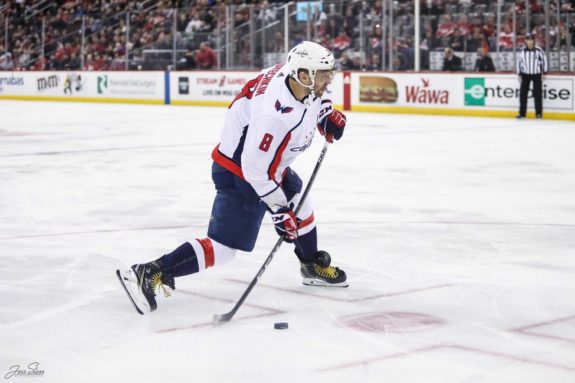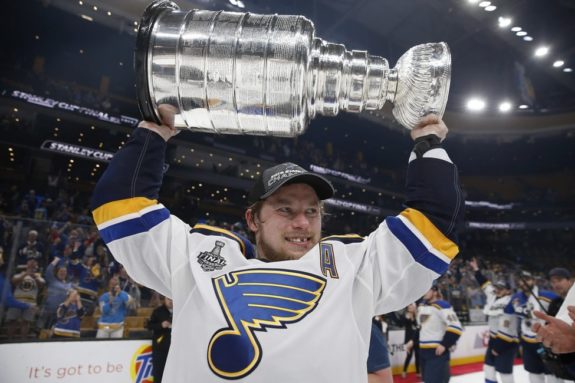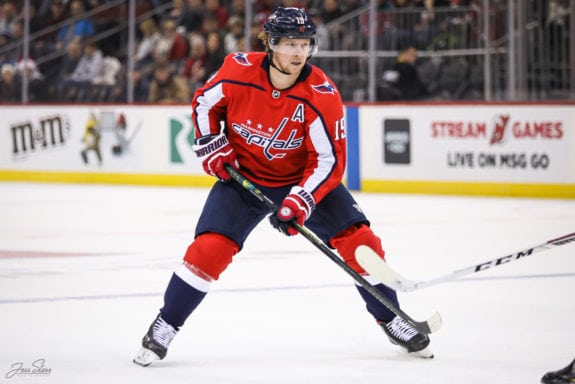The Washington Capitals return to playing meaningful hockey on Aug. 3 against the Tampa Bay Lightning after an over 140-day hiatus from action. They are jumping right into playoff hockey, which means every area that they were lacking in at the time of the stoppage will need to be improved upon — and quickly — if they want to go deep. One area of their game that will need some serious work is, surprisingly, the power play.
Related: Washington Capitals Logo History
As we all know, the Capitals’ power play has been an absolute wagon in the NHL for the last 10 years. They have terrorized shorthanded units unlike any other team in the league. The team possesses the best power-play percentage over the last 10 seasons at 22%. That is 1.2% better than the team in second. The gap between the team in second and the team in fifth is 0.5%, so the Capitals claim first place by a relatively large margin.
For those wondering, the second-place team happens to be their rivals, the Pittsburgh Penguins. There’s some firepower for Capitals fans. So, if any Penguins fans are ever chirping the Capitals about winning more series and Stanley Cups, throw that stat in their face. I am kidding, just so we’re clear.
On a serious note, the Capitals have essentially established the modern NHL power play template that teams like to attempt to emulate. Utilize forwards as opposed to defensemen and let them work the puck around to create openings. This, along with his world-class shot, is why Alex Ovechkin is third all-time in power-play goals.

That is why it’s concerning how below-average the Capitals’ power play has been this season. As a unit notorious for being nightmare-fuel to professional, shut-down hockey players, the power-play units have been uncharacteristically human this season. Special teams are integral to playoff success, and therefore, if the Capitals want to do something special with this postseason, they need to fix their power-play issues.
The Issues
When the sky fell and the world halted, the Capitals had a power-play percentage (PP%) of 19.44%. This placed their power play at 17th-best in the NHL, which is just not good enough. The league average was 20.03%, and the Capitals have way too many offensive weapons to be below the likes of the Minnesota Wild or the Dallas Stars in this department. No disrespect to either franchise, but as I mentioned the Capitals have the third-best power-play scorer of all time, and there is little doubt that he will be the best within a season or two. Not to mention, they also have some elite playmakers working the puck around.
Related: Top 15 NHL Power Forwards
Just to help prove something that every reader already knows, special teams are crucial to succeeding in the playoffs — Washington had a 29.3 PP% when they won the Stanley Cup in 2018. Just about 10% better than their current PP%. That is a lot of ground for the power-play unit to make up to be at their previous Stanley Cup power-play percentage.
The thing is, Washington doesn’t need to be scoring at their near-30% on the power play because that is higher than average. That is the sixth-best PP% of any playoff team in the last seven postseasons. They just need to improve upon their current 19.44 PP%. The Pittsburgh Penguins only had a 23.4% and a 20.5% during their respective Cup runs. These numbers are not out of this world. It just needs to be improved so their chances of scoring when they go a man up are higher than they are now, where they are hardly a threat.
The St. Louis Blues are an outlier, seeing as how they only had a 16.3 PP% when they won the Cup. That’s a risk the Capitals don’t want to take.

Although Washington has a trademarked power play and teams know that they are always looking for Ovechkin to unload a one-timer, the Capitals struggle with getting into the zone and getting set up. Two areas that are in need of some serious alterations are their breakout and zone entry.
Room for Improvement
The Capitals run this breakout called the “slingshot.” What the slingshot is, is the puck carrier (John Carlson) skates up to centre ice. From there, he turns around and passes the puck to two forwards swooping behind him (usually Nicklas Backstrom and Evgeny Kuznetsov). The idea of this is that whoever picks up the puck will have more room in their own zone to gather speed and carry the puck through the neutral zone and into the offensive zone.
The issue with this, is that since the opponent is backing up to cover Carlson, they basically have a wall of defenders at their blue line and bleeding into the neutral zone leaving whoever Carlson passes the puck to with very few lanes to navigate. The puck carrier tends to get caught at the blue line and the puck tends to get dumped back into the Capitals’ zone.
They need to move the puck more while moving up-ice towards the offensive zone, otherwise it’s just too easy to contain. As Patrick Holden of Russian Machine Never Breaks said in his article from earlier in the regular season discussing the team’s power-play issues, “There’s 64 feet from blue line to blue line on an NHL rink. If you give NHL players 64-plus feet to prepare for a zone entry with no passing through neutral, you are going to get stopped more often than not.”

An issue I don’t believe the Capitals have on their power play is the players on their primary unit.
The Personnel
Washington’s top power-play unit is one of the most envious top-five units you could strap skates on. Their first power-play unit consists of T.J. Oshie, Kuznetsov, Backstrom, Carlson and, of course, Ovechkin. That is one of the most creative and skilled group of offensive players in the last decade or two. I’m serious. Especially Oshie, Backstrom and Kuznetsov. These three guys are consistently fun to watch.
Related: Red Wings’ ‘Terrible’ Ted Lindsay – Honoring a Lasting Legacy
Not to mention, Ovechkin and Carlson on the back-end provide two of the best slapshots in the NHL, which goes without saying.
There was a point during the season amid the Capitals’ power-play struggles where the coaching staff elected to take Kuznetsov off of the first power-play unit and replaced him with Jakub Vrana. Although I love Vrana and think his shot would bring a different dynamic to the right side of the power play, you simply cannot take Kuznetsov off that unit. He is too offensively gifted and his vision is far too elite for him to not be passing to the likes of Ovechkin and Carlson for one-timers.
This gripe has been corrected for the postseason.
As we have learned from St. Louis, a good power play doesn’t guarantee you the Stanley Cup. It absolutely doesn’t hurt to have a great power play in the postseason where special teams are so important. The actual reason the Capitals’ average power play is an issue is because everybody knows how dominant it can be because of how dominant it has been in the past. If they can tweak it, there is no reason they can’t get back to that level of dominance on the man-advantage.
Then it’s up to the rest of the league to tweak their penalty kills in an attempt to stop them.